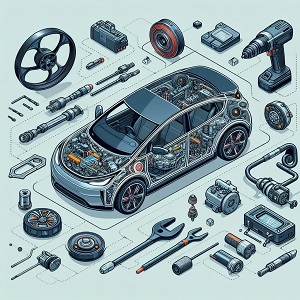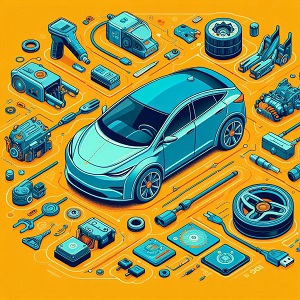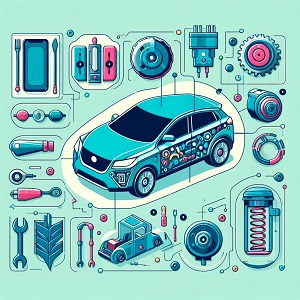
Electric Cars Working
Electric cars operate on a fundamentally different principle than traditional combustion engine vehicles. Understanding electric cars working can shed light on the intricate processes and technologies involved in their operation. From the conversion of electrical energy to mechanical propulsion to the utilization of advanced battery systems, electric cars showcase a remarkable blend of innovation and efficiency.
Electric cars (EVs) charge their batteries with electricity from the grid. Electric cars work by using electric energy to power an electric motor, which turns it into mechanical energy. This mechanical energy then makes the car move. EVs do not have a fuel engine like petrol or diesel cars. Instead, they use electric energy as their fuel.
Let’s explore the components that make up an all-electric car:
| Component | Description | Function |
|---|---|---|
| Battery Pack | Stores electrical energy | Powers the electric motor |
| Electric Motor | Converts electrical energy into mechanical energy | Propels the wheels of the car |
| Controller Unit | Manages the flow of electricity from the battery pack to the motor | Regulates the motor’s speed and torque |
| Inverter | Converts DC electricity from the battery pack into AC electricity | Used by the electric motor |
| Charger | Replenishes the electrical energy in the battery pack | Converts AC electricity from the grid into DC electricity |
| Transmission (In some electric cars) | Transfers mechanical power from the electric motor to the wheels | Improves efficiency and performance |
| Thermal Management System | Maintains proper operating temperatures for the battery pack, electric motor, and other components | Ensures optimal performance and longevity |
| Vehicle Control Unit (VCU) | Manages and coordinates various systems, including the electric motor, battery, charging, and regenerative braking | Serves as the “brain” of the electric car |
| Regenerative Braking System | Harnesses kinetic energy during braking or deceleration | Converts kinetic energy into electrical energy for storage in the battery |
Battery Pack:
The heart of an all-electric car is its battery pack. This high-capacity rechargeable battery stores electrical energy and powers the vehicle’s electric motor. The battery pack is typically composed of numerous lithium-ion cells connected in series or parallel configurations, providing the necessary energy to propel the vehicle.
Electric Motor:
The electric motor is responsible for converting electrical energy from the battery into mechanical power. It drives the vehicle’s wheels, generating torque to propel the car forward. Electric motors are known for their high efficiency and instant torque delivery, providing responsive and smooth acceleration.
Onboard Charger:
The onboard charger is an essential component that allows the electric car to recharge its battery pack from an external power source. It converts alternating current (AC) from the charging station or outlet into direct current (DC) to charge the battery. The charger is integrated into the vehicle and enables convenient and efficient charging.
Power Electronics:
Power electronics play a crucial role in managing the flow of electrical energy within the electric car. They control the conversion of DC power from the battery to AC power for the electric motor. They also regulate the power flow during regenerative braking, where kinetic energy is converted back into electrical energy and stored in the battery.

Thermal Management System:
Electric vehicles require a thermal management system to maintain proper operating temperatures for the battery pack, electric motor, and other components. This system ensures optimal performance and longevity by regulating temperature and cooling the components when needed.

Vehicle Control Unit (VCU):
The vehicle control unit serves as the “brain” of the electric car. It manages and coordinates various systems, including the electric motor, battery, charging, and regenerative braking. The VCU controls power distribution, monitors vehicle performance, and enables communication between different components.

Regenerative Braking System:
All-electric cars often feature regenerative braking, which harnesses kinetic energy during braking or deceleration. When the driver applies the brakes, the electric motor acts as a generator, converting the vehicle’s kinetic energy into electrical energy. This energy is then stored in the battery for later use, improving overall efficiency and extending the vehicle’s range.

Charging Port:
The charging port is the external interface that allows the electric car to connect to a charging station or power outlet. It provides a secure and standardized connection for charging the vehicle’s battery pack.
Instrument Cluster and Infotainment System:
Like traditional cars, electric vehicles have instrument clusters that display speed, battery status, range, and other relevant information. Additionally, infotainment systems provide features such as navigation, entertainment, and connectivity options, enhancing the overall driving experience.
Safety Systems:
All-electric cars are equipped with safety systems similar to those found in traditional vehicles. These systems include airbags, anti-lock braking systems (ABS), stability control, traction control, and advanced driver assistance systems (ADAS) that enhance safety and assist drivers in various driving scenarios.
DC-DC converter:
The DC-DC converter regulates the voltage of the battery pack to match the voltage requirements of the electric motor and other components.
Electrical wiring:
The electrical wiring connects all of the electrical components of the car, allowing electricity to flow from the battery pack to the motor, charger, and other components.
Cooling system:
The cooling system helps to keep the battery pack, electric motor, and other components cool. This is important because overheating can damage these components.
Suspension system:
The suspension system helps to smooth out the ride and improve handling.
Braking system:
The braking system is used to slow down and stop the car. Electric cars often use regenerative braking, which converts kinetic energy into electrical energy that can be stored in the battery.
Body and chassis:
The body and chassis are the structural components of the car. They provide support for the battery pack, electric motor, and other components.
These components work together to make an all-electric car function properly. As electric car technology continues to develop, we can expect to see even more innovative components that make these vehicles even more efficient, practical, and affordable.
Electric Powertrain and Motor Operation
At the heart of an electric car is its electric powertrain, which comprises an electric motor and a battery pack. The electric motor serves as the primary source of propulsion, converting electrical energy into mechanical power. When the driver engages the accelerator, the motor draws electrical energy from the battery and converts it into rotational motion. This process allows the electric car to generate the torque necessary to propel the vehicle forward.
Energy Storage: Advanced Battery Systems
Electric cars rely on advanced battery systems to store and deliver electrical energy. These batteries, typically lithium-ion-based, consist of multiple cells connected in series or parallel configurations. The batteries store electrical energy when the car is plugged into an external power source, such as a charging station or home charging unit. This stored energy is then discharged to power the electric motor when the car is in motion. The capacity and efficiency of the battery systems directly impact the range and performance of electric cars.
Charging Infrastructure and Charging Modes
To replenish the energy stored in the batteries, electric cars require access to charging infrastructure. Charging stations, located in public spaces or private residences, provide the necessary electrical power to charge the car’s battery. Electric cars can utilize different charging modes, including AC (alternating current) charging and DC (direct current) fast charging. AC charging is commonly used for overnight charging at home or in workplaces, while DC fast charging stations enable rapid recharging, allowing drivers to quickly top up their vehicle’s battery during longer journeys.
Regenerative Braking and Energy Recovery
Electric cars often come equipped with regenerative braking technology, which enhances energy efficiency and extends the vehicle’s range. When the driver applies the brakes, the electric motor transitions into a generator, converting kinetic energy into electrical energy. This energy is then stored in the battery for later use. Regenerative braking reduces reliance on traditional friction-based braking systems, thereby minimizing energy waste and increasing overall efficiency.
Vehicle Control and System Integration
Electric cars incorporate advanced systems for vehicle control and integration. Electronic control units (ECUs) oversee various aspects of the vehicle’s performance, including motor control, battery management, and energy distribution. These ECUs monitor and regulate the flow of electrical energy, ensuring optimal efficiency and safety. Additionally, electric cars employ sophisticated software algorithms to manage energy consumption, balance power demands, and maximize the driving range.
Range and Charging Considerations
The range of an electric car refers to the distance it can travel on a single charge. Factors such as battery capacity, driving conditions, and driving style influence the range of electric vehicles. Electric car manufacturers continuously strive to improve battery technology to increase range capabilities. Additionally, considering the availability and accessibility of charging infrastructure is crucial for electric car owners, as it impacts the convenience and practicality of long-distance travel.
Environmental Benefits and Sustainability
Electric cars offer significant environmental benefits, contributing to a more sustainable transportation ecosystem. By eliminating tailpipe emissions, electric vehicles help to reduce air pollution and greenhouse gas emissions, mitigating the adverse effects of climate change. Furthermore, the utilization of renewable energy sources for charging electric cars can further enhance their environmental credentials, leading to a cleaner and greener transportation system.
Advancements in Autonomous Features
The rise of electric vehicles coincides with advancements in autonomous driving technologies. Many electric cars are equipped with sensors, cameras, and advanced computing systems that enable various levels of autonomous driving capabilities. These features, such as adaptive cruise control and lane-keeping assist, enhance safety, convenience, and overall driving experience. The integration of electric and autonomous technologies paves the way for a future of efficient and intelligent mobility.
Ongoing Innovation and Future Prospects
The electric vehicle industry is characterized by ongoing innovation and continuous advancements. Manufacturers and researchers are actively exploring new battery chemistries, charging technologies, and materials to further improve electric car performance and reduce costs. The integration of renewable energy sources, vehicle-to-grid capabilities, and smart grid infrastructure holds the potential for a more interconnected and efficient electric vehicle ecosystem.
Understanding how electric cars work opens the door to a world of technological marvels and sustainable transportation solutions. The conversion of electrical energy into mechanical propulsion, advanced battery systems, regenerative braking, vehicle control systems, range considerations, environmental benefits, autonomous features, and ongoing innovation collectively shape the functioning and prospects of electric cars.
FAQ for Electric Cars Working
1. What are the main components of an electric car?
Electric cars consist of several key components:
Battery: The battery stores the electrical energy that powers the motor.
Electric motor: The motor converts electrical energy into mechanical energy, propelling the wheels of the car.
Controller: The controller regulates the flow of electricity from the battery to the motor.
Charger: The charger converts alternating current (AC) electricity from the grid into direct current (DC) electricity that can be stored in the battery.
2. How does the battery power the electric motor?
The battery stores electrical energy in the form of chemical potential energy. When the driver presses the accelerator pedal, the battery releases this energy in the form of electrons, which flow through the controller to the electric motor. The motor converts this electrical energy into mechanical energy, which turns the wheels of the car.
3. How does the electric motor convert electrical energy into mechanical energy?
The electric motor works on the principle of electromagnetism. When an electric current passes through a coil of wire, it creates a magnetic field. This magnetic field interacts with a permanent magnet or another set of coils, generating torque, which is the twisting force that turns the wheels of the car.
4. What are the different types of electric motors used in electric cars?
There are two main types of electric motors used in electric cars:
Direct current (DC) motors: DC motors use a commutator to reverse the direction of current flow, allowing the motor to rotate in both directions.
Alternating current (AC) motors: AC motors use an inverter to convert DC electricity from the battery into AC electricity, which is more efficient and can produce higher torque.
5. How does regenerative braking work in electric cars?
Regenerative braking is a feature that allows electric cars to recover energy when the brakes are applied. When the driver lifts off the accelerator pedal, the electric motor acts as a generator, converting the kinetic energy of the car’s movement back into electrical energy, which is then stored in the battery.
6. How does the range of an electric car depend on its battery capacity?
The range of an electric car is determined by the capacity of its battery, which is measured in kilowatt-hours (kWh). The larger the battery capacity, the longer the range of the car.
7. What factors affect the range of an electric car?
In addition to battery capacity, several factors can affect the range of an electric car, including:
Driving habits: Aggressive driving, such as rapid acceleration and hard braking, can reduce range.
Weather conditions: Colder weather can reduce battery efficiency and range.
Accessories: Using accessories like heated seats and air conditioning can also reduce range.
8. How do electric cars charge?
Electric cars can be charged using a variety of methods:
Level 1 charging: This is the slowest charging method, using a standard 120-volt household outlet.
Level 2 charging: This is a faster charging method, using a 240-volt outlet or a dedicated charging station.
DC fast charging: This is the fastest charging method, using a high-voltage DC charger that can add hundreds of miles of range in just a few minutes.
9. How long does it take to charge an electric car?
The charging time for an electric car depends on the size of the battery, the charging method, and the power output of the charger. Level 1 charging can take several hours to fully charge a car, while DC fast charging can take as little as 30 minutes.
10. What is the future of electric car technology?
Electric car technology is constantly evolving, with advancements in battery technology, charging infrastructure, and motor efficiency. As technology continues to improve, electric cars are expected to become more affordable, efficient, and accessible, making them a more attractive option for consumers.